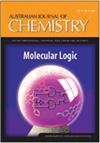Electronic structure study of H3BXH3 (X═B, N and P) as hydrogen storage materials using calculated NMR and XPS spectra
IF 0.9
4区 化学
Q4 CHEMISTRY, MULTIDISCIPLINARY
引用次数: 0
Abstract
Boron-based materials have been used for hydrogen storage applications owing to their high volumetric and gravimetric hydrogen density. The present study quantum mechanically investigates the electronic structures of three compounds: diborane (DB, B2H6), ammonia borane (AB, H3BNH3) and phosphine borane (PB, H3BPH3). The exploration is facilitated using calculated nuclear magnetic resonance (NMR) chemical shifts, together with outer valence ionisation potentials (IP) and core electron binding energy (CEBE). The findings show a distinct electronic structure for diborane, differing notably from AB and PB, which exhibit certain similarities. Noteworthy dissimilarities are observed in the chemical environments of the bridge hydrogens and terminal hydrogens in diborane, resulting in a substantial chemical shift difference of up to 5.31ppm. Conversely, in AB and PB, two distinct sets of hydrogens emerge: protic hydrogens (Hp–N and Hp–P) and hydridic hydrogens (Hh–B). This leads to chemical shifts as small as 0.42ppm in AB and as significant as 3.0ppm in PB. The absolute isotropic NMR shielding constant (σB) of 11B in DB is 85.40ppm, in contrast to 126.21ppm in AB and 151.46ppm in PB. This discrepancy indicates that boron in PB has the most robust chemical environment among the boranes. This assertion finds support in the calculated CEBE for B 1s of 196.53, 194.01 and 193.93eV for DB, AB and PB respectively. It is clear that boron in PB is the most reactive atom. Ultimately, understanding the chemical environment of the boranes is pivotal in the context of dehydrogenation processes for boron-based hydrogen storage materials.H3BXH3 (X = B, N和P)作为储氢材料的电子结构研究
硼基材料由于其高的体积和重量氢密度而被用于储氢应用。用量子力学方法研究了二硼烷(DB, B2H6)、氨硼烷(AB, H3BNH3)和膦硼烷(PB, H3BPH3)的电子结构。利用计算的核磁共振(NMR)化学位移,以及外价电离势(IP)和核心电子结合能(CEBE),促进了勘探。结果表明,二硼烷具有独特的电子结构,与AB和PB具有一定的相似性。在二硼烷的桥氢和末端氢的化学环境中观察到明显的差异,导致化学位移相差高达5.31ppm。相反,在AB和PB中,出现了两组不同的氢:质子氢(Hp-N和Hp-P)和氢化氢(Hh-B)。这导致AB的化学位移小至0.42ppm, PB的化学位移大至3.0ppm。11B在DB中的绝对各向同性核磁共振屏蔽常数(σB)为85.40ppm, AB中的为126.21ppm, PB中的为151.46ppm。这一差异表明PB中的硼在硼烷中具有最稳定的化学环境。这一断言在DB、AB和PB计算的b15的CEBE分别为196.53、194.01和193.93eV中得到了支持。PB中的硼是最活泼的原子。最后,了解硼烷的化学环境对于硼基储氢材料的脱氢过程至关重要。
本文章由计算机程序翻译,如有差异,请以英文原文为准。
求助全文
约1分钟内获得全文
求助全文
来源期刊

Australian Journal of Chemistry
化学-化学综合
CiteScore
2.50
自引率
0.00%
发文量
65
审稿时长
1.3 months
期刊介绍:
Australian Journal of Chemistry - an International Journal for Chemical Science publishes research papers from all fields of chemical science. Papers that are multidisciplinary or address new or emerging areas of chemistry are particularly encouraged. Thus, the scope is dynamic. It includes (but is not limited to) synthesis, structure, new materials, macromolecules and polymers, supramolecular chemistry, analytical and environmental chemistry, natural products, biological and medicinal chemistry, nanotechnology, and surface chemistry.
Australian Journal of Chemistry is published with the endorsement of the Commonwealth Scientific and Industrial Research Organisation (CSIRO) and the Australian Academy of Science.
 求助内容:
求助内容: 应助结果提醒方式:
应助结果提醒方式:


